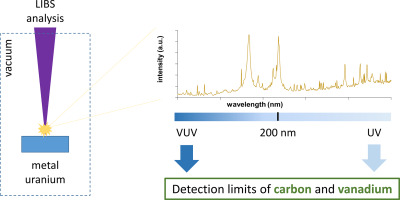当前位置:
X-MOL 学术
›
Spectrochim. Acta B. At. Spectrosc.
›
论文详情
Our official English website, www.x-mol.net, welcomes your feedback! (Note: you will need to create a separate account there.)
Laser-induced breakdown spectroscopy of uranium in the VUV range
Spectrochimica Acta Part B: Atomic Spectroscopy ( IF 3.3 ) Pub Date : 2020-04-01 , DOI: 10.1016/j.sab.2020.105796 E. Rollin , O. Musset , D. Cardona , J.-B. Sirven
Spectrochimica Acta Part B: Atomic Spectroscopy ( IF 3.3 ) Pub Date : 2020-04-01 , DOI: 10.1016/j.sab.2020.105796 E. Rollin , O. Musset , D. Cardona , J.-B. Sirven

|
Abstract Quantitative analysis of impurities in nuclear materials is necessary in a number of areas, including process control during manufacturing, quality control of products, or for nuclear forensics purposes. Due to the important handling constraints induced by the samples radioactivity and their containment inside airtight enclosures, optical analytical techniques have great advantages over standard ones that require sample preparation, like ICP-based techniques. Therefore, laser-induced breakdown spectroscopy (LIBS) is developed for fast quantitative analysis of impurities in uranium. Actinides are well-known to have a very large number of emission lines in the UV–visible spectral range, hence making the detection of trace or minor elements a real challenge. Therefore, in this study we explored the vacuum ultraviolet range (VUV), i.e. below 200 nm, in order to investigate if this spectral region is more favorable for elemental analysis of uranium by LIBS. As practically no data on VUV spectroscopy of uranium are available, we first analyzed the spectra obtained to assess the spectral density of uranium lines, both in the UV and VUV. Then, the detection limits of two elements, carbon and vanadium, were estimated. It was found that, in spite of a less dense and less intense uranium background in the VUV, this spectral region is not relevant for metal impurities whose spectra are marginally analytically useful in the VUV. Conversely, for non-metals having intense lines in the VUV, the detection limit can be significantly better than in the UV. This was already known for non-nuclear samples. This study extends that conclusion to nuclear materials and has important practical consequences on the implementation of a LIBS analyzer in a nuclear facility.
中文翻译:

真空紫外范围内铀的激光诱导击穿光谱
摘要 核材料中杂质的定量分析在许多领域都是必要的,包括制造过程控制、产品质量控制或核取证目的。由于样品放射性及其封闭在密闭外壳内引起的重要处理限制,光学分析技术比需要样品制备的标准技术(如基于 ICP 的技术)具有很大的优势。因此,开发了激光诱导击穿光谱 (LIBS) 以快速定量分析铀中的杂质。众所周知,锕系元素在紫外-可见光谱范围内具有大量发射线,因此使痕量或微量元素的检测成为一个真正的挑战。因此,在这项研究中,我们探索了真空紫外线范围(VUV),即 低于 200 nm,以研究该光谱区域是否更适合 LIBS 对铀进行元素分析。由于几乎没有铀的 VUV 光谱数据可用,我们首先分析了获得的光谱,以评估 UV 和 VUV 中铀谱线的光谱密度。然后,估算了碳和钒这两种元素的检出限。已经发现,尽管真空紫外线中铀的背景密度较低且强度较低,但该光谱区域与金属杂质无关,其光谱在真空紫外线中的分析用处不大。相反,对于在 VUV 中具有强线的非金属,检测限可能明显优于 UV。这对于非核样本来说已经是众所周知的了。
更新日期:2020-04-01
中文翻译:

真空紫外范围内铀的激光诱导击穿光谱
摘要 核材料中杂质的定量分析在许多领域都是必要的,包括制造过程控制、产品质量控制或核取证目的。由于样品放射性及其封闭在密闭外壳内引起的重要处理限制,光学分析技术比需要样品制备的标准技术(如基于 ICP 的技术)具有很大的优势。因此,开发了激光诱导击穿光谱 (LIBS) 以快速定量分析铀中的杂质。众所周知,锕系元素在紫外-可见光谱范围内具有大量发射线,因此使痕量或微量元素的检测成为一个真正的挑战。因此,在这项研究中,我们探索了真空紫外线范围(VUV),即 低于 200 nm,以研究该光谱区域是否更适合 LIBS 对铀进行元素分析。由于几乎没有铀的 VUV 光谱数据可用,我们首先分析了获得的光谱,以评估 UV 和 VUV 中铀谱线的光谱密度。然后,估算了碳和钒这两种元素的检出限。已经发现,尽管真空紫外线中铀的背景密度较低且强度较低,但该光谱区域与金属杂质无关,其光谱在真空紫外线中的分析用处不大。相反,对于在 VUV 中具有强线的非金属,检测限可能明显优于 UV。这对于非核样本来说已经是众所周知的了。



























 京公网安备 11010802027423号
京公网安备 11010802027423号